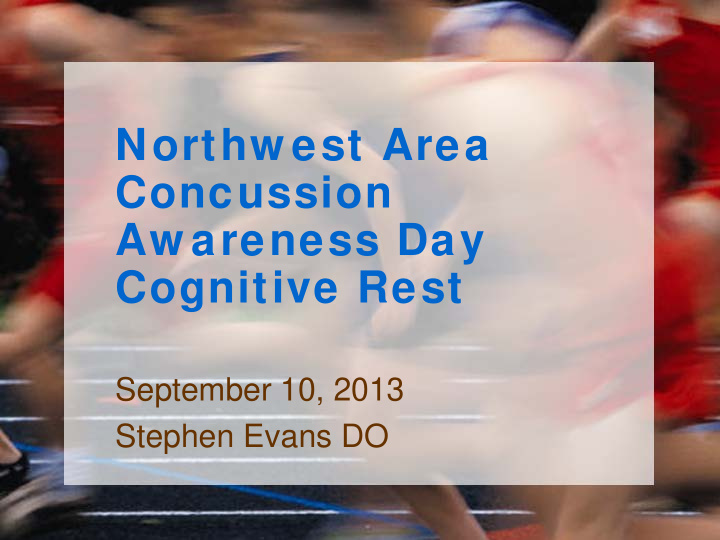



Northw est Area Concussion Aw areness Day Cognitive Rest September 10, 2013 Stephen Evans DO
Concussions Happen • Sports (per • Accidents 100,000) – Falls • •Football: 64 -76.8 – Car Accidents • •Boys' ice hockey: 54 • •Girl's soccer: 33 – Bicycles • •Boys' lacrosse: 40 - 46.6 • •Girls' lacrosse: 31 - 35 • •Boys' soccer: 19 - 19.2 • •Boys' wrestling: 22 - 23.9 • •Girls' basketball: 18.6 - 21 • •Girls' softball: 16 - 16.3 • •Boys' basketball: 16 - 21.2 • •Girls' field hockey: 22 - 24.9 • •Cheerleading: 11.5 to 14 • •Girls' volleyball: 6 - 8.6 • •Boys' baseball: Between 4.6 - 5 • •Girls' gymnastics: 7 • •Girls' swim/dive: 2 • •Girls' track/field: 2 • •Boys' track/field: 2 • •Boys' swim/dive: 1
Pam Oliver Hit on Sideline
Focus on Recovery • Some of the best information has been gathered through the NCAA. These are student athletes in academic settings that are well funded. • Grades, health-status, mental well- being, and a multitude of other measures have been followed for decades.
What Have They Found? • Some concussions take more time to recover- sometimes months or even longer. • A decline in grades is NOT uncommon. • Healing times MAY be reduced with cognitive rest.
So What is Cognitive Rest? • Decreased school work • Decreased stress • Decreased disturbances • Sounds Great! Sign me up!
What This Really Means • A individualized lesson plan with progressive return to regular classroom activity. – individualized testing- may interfere with college plans (SAT’s, etc.) • No or decreased use of cell phones, computers, TV, video games, reading, or other distractions.
Continued • Less or no time out with friends. • No or less chores. (or simplified duties) • No driving. • No other sports, swimming
Why? • The less mental taxing environment on the brain allows for quicker return to normalcy. • Restrictions may be slowly progressed back to normal as the physical limitations are.
Do We Alw ays Need to Do This? • Not exactly. • Initially we do. • In most cases the symptoms resolve quickly and do not need to continue or add restrictions. • In cases where people are not improving, the treatment plan must be individualized. • http://www.brainsteps.net/_orbs/about/index. aspx
Take Home Point…Use Your Head… or Rest it…
References • 1. Giza CC, Hovda DA. The neurometabolic cascade of concussion. J Athl • Train. 2001;36(3):228-235. • 2. Broglio SP, Puetz TW. The effect of sport concussion on neurocognitive • function, self-report symptoms and postural control: a meta-analysis. • Sports Med. 2008;38(1):53-67. • 3. Belanger HG, Vanderploeg RD. The neuropsychological impact of • sports-related concussion: a meta-analysis. J Intl Neuropsychol Soc. • 2005;11:345-357. • 4. McCrory P, Johnston KM, Meeuwisse W, et al. Summary and agreement • statement of the 2nd International Conference on Concussion • in Sport, Prague 2004. Clin J Sport Med. 2005;15(2):48-55. • 5. McCrory P, Meeuwisse W, Johnston K, et al. Consensus statement on • concussion in sport: the 3rd International Conference on Concussion • in Sport held in Zurich, November 2008. Br J Sports Med. May 2009;43 • Suppl 1:i76-90. • 6. Logan K. Cognitive rest means I can’t do what?! Athl Train Sports • Health Care. 2009;1(6):251-252. • 7. Purcell L. What are the most appropriate return-to-play guidelines for • concussed child athletes? Br J Sports Med. May 2009;43 Suppl 1:i51-55. • 8. Centers for Disease Control and Prevention, National Center for Injury • Prevention and Control. Heads Up: Brain Injury in Your Practice. A Tool • Kit for Physicians. Available at: http://www.cdc.gov/ncipc/tbi/physicians_tool_kit.htm. Accessed November 15, 2009.
Recommend
More recommend